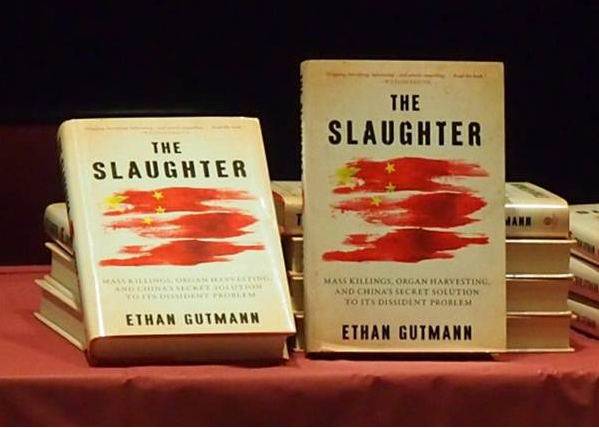Plenty of lurid details, but a dearth of solid proof.

I’m not sure what to make of Ethan Gutmann’s latest book, The Slaughter: Mass Killings, Organ Harvesting, and China's Secret Solution to Its Dissident Problem. His first book, Losing the New China: A Story of American Commerce, Desire and Betrayal (2004) was offputting to this old China hand who could pick numerous holes in the poor scholarship. Indeed, it seemed that he was more interested in scolding China rather than giving a balanced assessment of American business there.
Ten years on and Gutmann’s approach has not changed. Although The Slaughter deals with serious allegations about human rights violations – that the Chinese government is harvesting organs from prisoners before and after death – it is a disappointing investigation.
Despite his credentials as a foreign policy expert who has provided briefings to the Central Intelligence Agency and other US security agencies, and as an investigative journalist writing for The Wall Street Journal amongst other publications, Gutmann’s book is a poor journalism and scholarship.
A key weakness of The Slaughter is that Gutmann relies on the testimony of just a handful of Falun Gong refugees who, he says, “had experienced something inexplicable in a medical setting.” He speculates that what they had experienced was an examination to determine whether their organs were sufficiently healthy for sale on the world black market for human organs. Gutmann’s excuse for the thin field of eyewitnesses is that few Falun Gong members have been able to escape captivity to tell their tales outside China.
Although Gutmann also interviewed some 100 other witnesses – such as Nijat Abdureyimu, a Uyghur policeman who served in a special squad involved in organ harvesting – they also fail to bolster his case. They relate to occurrences in the late 1990s and early 2000s. Little evidence is provided that organ harvesting is still taking place in 2015 – apart from the Falun Gong refugees who were subjected to an “inexplicable” medical examination while in prison.
Another weakness of The Slaughter is that it provides a lengthy, detailed and unnecessary history of the Falun Gong. It leaves the reader asking where is this going and why. And although it raises a critical question about why the Chinese Government has so ruthlessly persecuted the Falun Gong it fails to deliver an answer to the question. This is disappointing because the answer is simple; it does not require a PhD in Chinese history or politics.
Anyone who has spent time in China, should be able to give an answer. It goes to the Chinese Government’s fear of mass movements inspired by millenarian religious cults. China’s historical experience of such cults drives the government’s fear of underground movements. Consider the White Lotus Society rebellion from 1794 to 1804; hundreds of thousands died and the Qing dynasty was fatally weakened. Consider the Taiping rebellion from 1850 to 1864; it left 20 million people dead. Consider the Boxer (Militia United in Righteousness) rebellion from 1899 to 1901; a hundred thousand people died and the government dissolved into chaos.
This historical experience makes the Communist Government highly suspicious of all religious movements outside its control, such as the underground Catholic Church, the Protestant house church movement, and Falun Gong. Of these, Falun Gong represents the biggest threat because of the speed with which it arose and the fact that it attracted Communist Party members to its ranks. Gutmann didn’t need to explain this, but having raised the question he could have done so in less than a chapter of the book.
The Slaughter is not an easy read. The subject matter aside (political suppression, torture, mass killings and organ harvesting), Gutmann’s ponderous style and the copious details mean The Slaughter reads like a university textbook.
However, the worst aspect of the book is its failure to deliver conclusive evidence that human organ harvesting continues in China today. Even the Gunther von Hagens’ ghoulish art show of plastinated cadavers – many of which are said to be the bodies of executed Falun Gong members – is dated. Gutmann even delves into the depths of conspiracy theory to link von Hagens to ousted Chinese political leader Bo Xilai and the initial crackdown on Falun Gong. To this old China hand it sounds very far-fetched.
Unfortunately The Slaughter sheds little light on Beijing’s current treatment of political and religious dissent. The book lacks sufficient evidence to support Gutmann’s claim that the Chinese Government continues to murder and harvest the organs of dissenters. In the Scottish legal system, a jury can give three verdicts: not guilty, guilty and not proven. On the basis of the case mounted here, I must acquit the defendant with a "not proven" verdict.
The reader can find similar allegations in the Falun Gong’s international publication The Epoch Times, which is referenced on occasion by Gutmann, without question. At least its articles are shorter and better written.

Alistair Nicholas is a public affairs professional who works with Australia's federal and state governments.
Source From:
http://www.mercatornet.com/articles/view/verdict-on-chinese-organ-harvesting-not-proven/16225